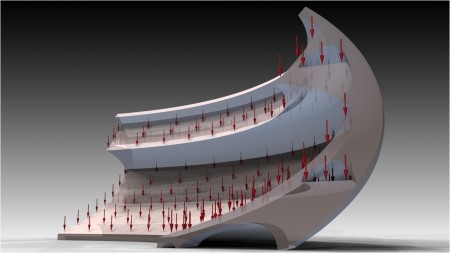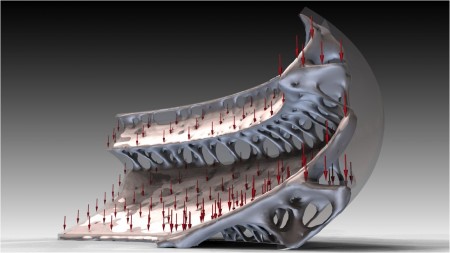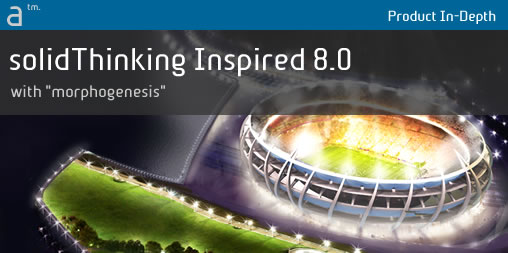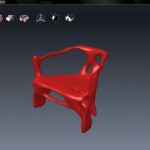Continued from page 1
morphogenesis Technology: solidThinking for Architecture
A new product is solidThinking Inspired 8.0 with morphogenesis technology. morphogenesis is the first example of new programming technology that represents a future of modules for solidThinking. While morphogenesis is its own unique program with its own unique user-interface (UI), it is built to work in tandem with solidThinking proper as a module. Users can generate models in solidThinking and take them into morphogenesis for a new type of form making work.
Advertisement
The new form generation technology is actually based on technology that came from solidThinking’s parent company Altair. Scientists have learned to generate algorithms that simulate nature’s reaction to environmental forces–such as the forces that shape bone growth in humans and animals. The shapes produced by these algorithms can be used generatively and notionally to design efficient and light-weight structures used in a wide variety of applications. This would include architectural structures as well as industrial designed objects, especially those which are subjected to many environmental or situational forces.
Key areas for this technology include aircraft, architecture, ground vehicles, medical implants, electronics and even toys. solidThinking Inspired 8.0 is the first product to bring such technology to the design process at the ideation phase of product design and architecture.
Morphogenesis: Details
What morphogenesis does is enable the designer to define a boundary volume for his designed object from which forces will be applied; the algorithm is then applied to this “design space” to generate a form.
The user chooses a type of material for his object (eg: metal, glass, cement, etc.) and then specifies supports, forces and other constraints that his object will be subjected to in its environment. Supports can be the ground, pins, clamps, and walls, that hold the object in place. Forces are a push or pull force or torques applied to the object…and the affect of gravity can be applied as well. Additionally, pressures can also be applied such as air or water pressure.
The goal of the resulted form is not necessarily to run with a biologically-determined form but to be “inspired” by nature’s design cues. What morphogenesis technology does is “mimic” nature’s method of design.

06 – Within architecture morphogenesis technology can allow the designer to mimic what nature would do with this problem by applying real-life loading and environmental pressures. In this example after concrete was chosen as its material, gravitational forces on the stadium structure were applied to inform the algorithm.

06a – The result of the algorithm applied above. As you can see the sectional profile of the stadium structure has been dramatically altered, suggesting both structural and purely aesthetic possibilities. The result of this approach leads to the final structure shown in the image below.
solidThinking veteran users may notice that the user-interface of the morphogenesis module with solidThinking Inspire 8.0 looks nothing like solidThinking. Alex Mazzardo said the company rethought the user-interface of the morphogenesis module from the ground up. This is a completely separate program that gets launched from a button within solidThinking, so the company had an opportunity to advance UI design. These new modules of which morphogenesis is the first will give the company opportunities to investigate and try out new user-interface paradigms within smaller programs…with the hope that the best of what works well will find its way back into the main solidThinking program in future versions.
Looking more closely at what morphogenesis does, you can see from image 04 above that the user specifies what percentage of the “design space” to keep. The algorithm is then applied to those parameters. The user is able to specify real loads and run the algorithm as many times under various combinations of percentages and force values to generate iterative design options.
The results that can be generated by morphogenesis are quite stunning. Two examples include this ultra-futuristic motorcycle design and the stadium architectural design (see images 07 – 09).

09 – The results of the morphogenesis work led eventually to this finished design of the motorcycle. solidThinking Inspire 8.0 with morphogenesis technology became the unique basis of inspiration for this stunning bike design.
As you can see, solidThinking Inspired 8.0 with morphogenesis technology adds a new layer of design thinking to the creative process by allowing the designer to study and review how nature would most likely solve the same problem, yet back off from the literal and strict bio-natural response to environmental forces at various degrees of subtlety.
To learn more about solidThinking Inspired 8.0 with morphogenesis technology go here: www.solidthinking.com. You will also find more information and related articles below in the Related Articles links (below) and our Cloud Tag at right.








Reader Comments
Comments for this story are closed